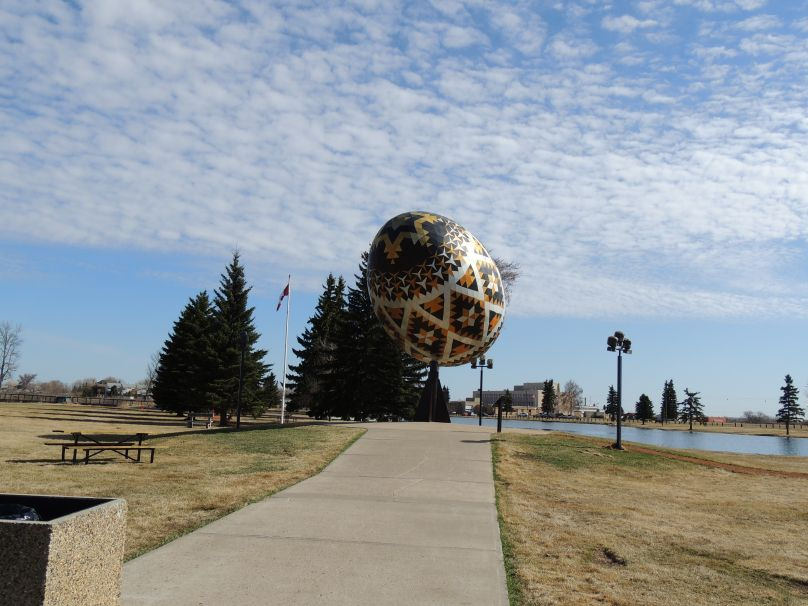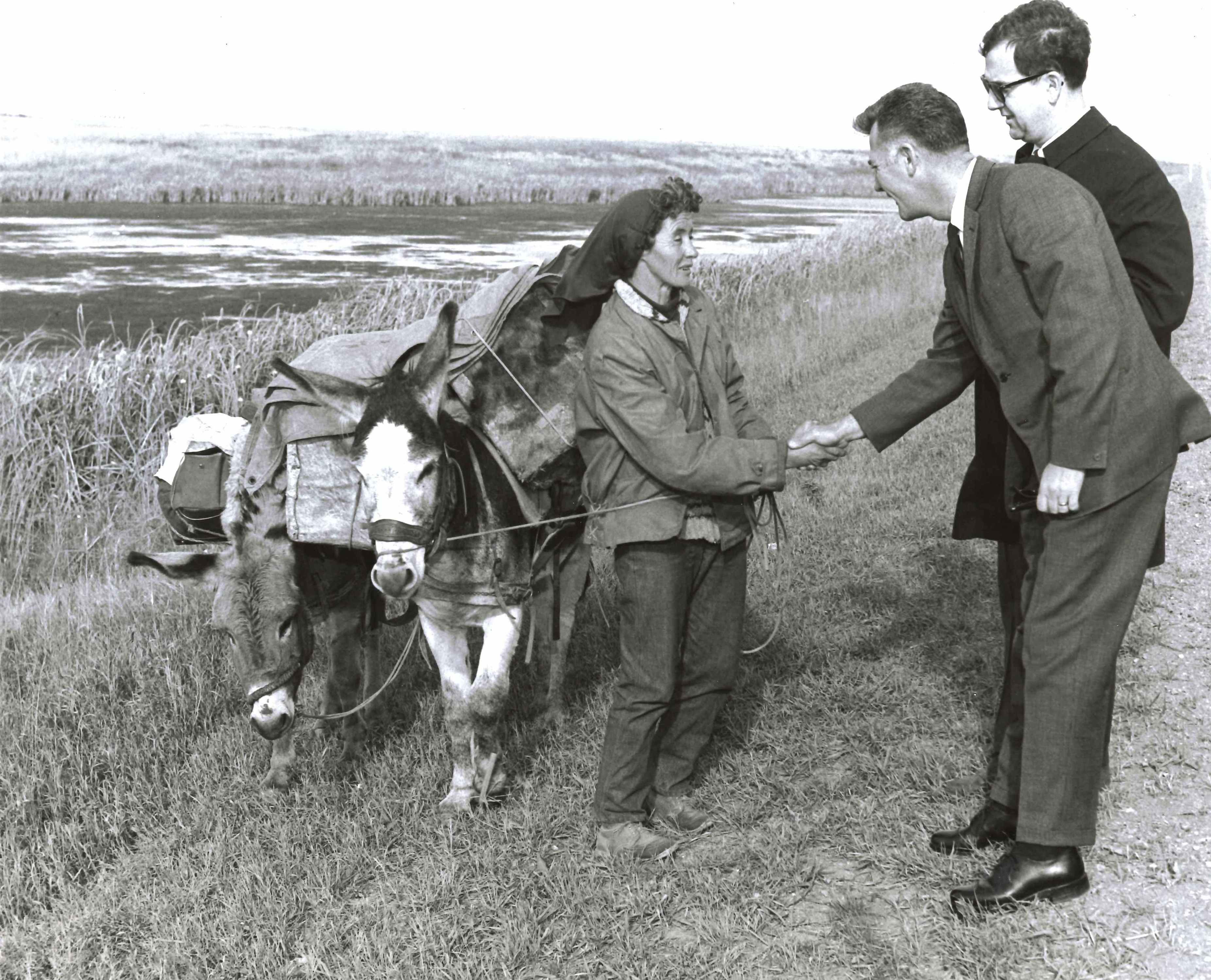[Editor’s note: The Canadian government is spending more than $500 million to celebrate Canada’s 150th birthday.
But it’s a safe bet that money won’t buy the inspiration, craziness and spirit of Canada’s Centennial in 1967.
That strangely uncharacteristic burst of national celebration was the inspiration for Tyee contributor and author Tom Hawthorn’s new book, The Year Canadians Lost Their Minds and Found Their Country: The Centennial of 1967.
Hawthorn looks back to the year of Expo 67 and the ways Canadians set out to celebrate the first 100 years of Confederation. He will be launching the book at 6 p.m. on May 31 at the Museum of Vancouver, 1100 Chestnut St. Admission to the book launch is included in the museum admission, which varies from $8 to $18. For more information about the book launch, please visit www.museumofvancouver.ca or phone (604) 736-4431.
Among the most interesting were the Canadians who decided to mark the Centennial by trying to conquer the land’s vast geography. Canoeists paddled from the Rocky Mountains to Expo 67. A man drove a Model T from Vancouver to Montreal. Others walked, roller-skated, or helicoptered from coast to coast.
In this excerpt, Hawthorn tells the story of Ida DeKelver, who left her British Columbia sheep ranch on a peculiar odyssey of her own.]
When Ida DeKelver set off by foot from her ranch home in an isolated British Columbia valley, she was accompanied by two donkeys, Jack and Bill. Between them, they carried 140 pounds of provisions. She planned on riding Bill much of the way.
Her destination was her hometown in Saskatchewan, some 1,400 kilometres to the east on the other side of the Rocky Mountains.
On the morning of Sept. 15, 1967, she sent the children off to school before bidding adieu to her husband, Emil, who was left to carry out chores on their sheep ranch. Four friends were on hand to wish her off. “You’ll phone back for someone to pick you up at the end of the first 100 miles,” one of them said.
Bill the donkey quickly tired from carrying a passenger, so Ida redistributed the load, with the older, lead donkey hauling the bulk. The packs included 20 pounds of oats for the animals, two pairs of shoes, cookies, chocolate bars, and two jackets, one of which she made from an air force “teddy bear,” a fleece-lined jacket issued to aircrew. A movie camera, a projector, and films in canisters were the heaviest items. DeKelver had been unable to get the donkeys shod as no blacksmith had shoes small enough to fit them. Every night, she rubbed salve into the hooves. She immediately abandoned the notion of riding, determining she would walk the entire way, too.
DeKelver’s Centennial trek was planned as an homage to the Overlanders, a group of some 115 settlers, all men but for one woman and her three children, who travelled from Ontario to the British Columbia Interior in 1862. After arriving in Fort Garry (present-day Winnipeg), the Overlanders hauled Red River carts to Fort Edmonton, where they traded the carts for pack horses. A returning party of gold miners from the Cariboo fields encouraged them to follow the Yellowhead Pass through the mountains. Native guides were hired to lead them through the treacherous passage.
The group broke up into smaller parties. They suffered great privation along the way, coming close to starvation. One group became stranded by floodwaters only to be rescued in the nick of time by a trailing party. Later, they lost many provisions and four died from drowning and exposure after canoes carved from hollowed-out logs capsized in rapids on the Fraser River.
A smaller, trailing group, which included the woman and her three children, tried to get to the gold fields by following an overland route, purchasing 100 head of cattle and horses. Too late, they discovered they would need to travel along the Thompson River. The horses were loosed and the cattle slaughtered. They built canoes, but lost two men in an area of rapids known as Hell’s Gate. At long last, the group arrived in Kamloops on Oct. 12, 1862. The next day, Catherine O'Hare Schubert, who had made the journey pregnant, gave birth to a baby girl, who was named Rose, a sister for five-year-old son Gus, three-year-old Mary Jane, and a year-old infant. Her husband, Augustus, a carpenter, went off to work in the goldfields.
The story of the Overlanders was well known in the North Thompson region of British Columbia. DeKelver wished to honour brave Catherine Schubert and promote the Yellowhead Route while celebrating Canada's Centennial. An overland trek of her own seemed the way to do so.
The DeKevlers moved to the Clearwater Valley in 1959, before telephone service had even reached the district, settling on an 80-acre farm alongside Candle Creek. Three years later, they purchased 100 ewes and rams, as well as a grazing lease on nearby Trophy Mountain. They tripled the size of the herd. It took three days to move the herd from farm to meadows, giving Ida a sense of what confronted her as she planned her journey. Both worked as guides in the area, even getting a chance to name some features, such as Buck Hill, which Ida named for the plentiful deer in the area. Later, a 40-metre waterfall along Third Canyon Creek would be named Ida Falls in her honour.
Before Ida embarked on her journey, she and Emil spread out a road map to plot likely stops along the Yellowhead Highway, along which she planned to travel. She wrote letters to local clubs and dignitaries announcing her project and seeking assistance. A typical response came from Dr. E.M. Martinuk, a chiropractor who headed a local Centennial committee in Saskatchewan. He wrote: “I would like to offer you a free stay (for yourself and the donkeys) as you come through Humboldt. I do hope your trip will be uneventful and may God keep you safe in your journey.” The letter is now to be found posted on a Facebook page for the now-defunct Yellowhead Museum.
Having plotted her path, Ida next took her camera to film natural scenes in Clearwater, including her own ranch, and the unspoiled wilderness of nearby Wells Gray Provincial Park. She put together a film promoting the area, covering the cost of processing by charging local businesses $10 to have advertisements inserted in the movie. The chamber of commerce in Clearwater decided to sponsor her trip as a means of promoting motor travel along the Yellowhead Highway, which was still in the process of being improved and paved.
On her first day, Ida walked just 26 kilometres east to Vavenby, a mill town, which she reached in the afternoon. She showed her film at the Legion Hall before spending the night with a local couple.
She tramped 45 kilometres on her second day, stopping at the Trimble farm at Avola, where she once again showed her film.
A lean, wiry figure, hardened by labour on her ranch, Ida wore loose dungarees and a pair of boys’ size 5 shoe with soft leather uppers and a sole thick enough that she would only feel stubble underfoot in the final two days of the walk. She held her hair in place with a kerchief, the wind whipping her bangs. Work gloves protected her hands from the wind and chaffing as she held onto the rope on which the donkeys were leashed. The monotony of walking through wilderness accompanied only by two beasts of burden did not faze Ida, for whom solitude was familiar from working in isolation on the ranch. Besides, she liked how the pace made her feel.
“It makes your muscles and nerves really alive,” she said. “Your lungs are better for the breathing that goes with steady walking.” On the third day, she was put up at the Tote Road Inn, which offered “cottages, souvenirs, confectionary” in Gosnell, a tiny wayfarers stop, named after the province's first provincial librarian and archivist, at the confluence of the North Thompson and Albreda rivers. During the Second World War, an internment camp for Japanese-Canadians was established in the hamlet. Work crews from the camp repaired and improved the unpaved highway. In a daily diary published after her trek, ida recounted a “very warm welcome” from the innkeepers. Two days later, she arrived Valemount to hear gathered schoolchildren cry, “The donkeys are coming!”
As word of her trip spread, she was greeted along the highway by well-wishers who brought her coffee, doughnuts, sandwiches and, on one memorable occasion, roast chicken from a café up the road. “I proved the old Canadian hospitality is as much alive as it was 100 years ago,” she said.
On her fifth day on the road, she walked as far as she anticipated, so camped out in a field, spreading out her bedroll between the donkeys. They were placed as sentries to alert her to any intrusions by wildlife. The following night she slept at the picnic grounds at Lucerne, a railway ghost town on Yellowhead Lake, 37 kilometres from Jasper.
Ida crossed the provincial border at about one o’clock on September 23. She was met at the Jasper Park gates by park officials and Jasper chamber of commerce executives. They invited her to attend a musical show, while the donkeys were put up in government barns. Byron Moore, the railway station manager, and his wife offer to put Ida up for the night. (Moore, an air force veteran from the Second World War and a train buff, would be one of 23 killed in the fiery Hinton train disaster in 1986, when the Via train in which he was a passenger was struck by a freight train.)
At the eastern end of the park, she stayed at the Circle M, a dude ranch. Some miles further on, she arrived in Hinton, where the proud citizenry took her on a guided tour of the pulp mill. Her reward was a night in a motel. The following night she was once again kipping down in a field off the highway, between Bill and Jack. The younger donkey had fallen lame, so in Edson a cobbler was asked to fashion some footwear for the hobbling critter. Jack “is likely the only donkey in Canada that can boast of owning a pair of boots,” the Edson Leader newspaper proclaimed.
The weather turned and outside Evansburg Ida was “cold [and] miserable day and night.”
On she walked, reaching Edmonton on Oct. 3, continuing on to Vegreville, an agricultural town with a large Ukrainian population. (Later, in 1973, a pysanka — Ukrainian Easter egg — was built to mark the centennial of the Royal Canadian Mounted Police.)

Days passed. Ida kept walking, through Vermilion (named for the red clay in the river valley) and Kitscoty and the border-straddling city of Lloydminster, where the donkeys were “the main attraction and were treated very well by everyone,” according to her diary as later published by her hometown newspaper.
As her trek continued through her birth province, the odd figure of this determined woman, accompanied by donkeys, became something of a celebrity. Newspapers regularly reported on her progress as she made her way through Maidstone and Delmas and into North Battleford, where Barry Conkin, the local centennial committee chairman, hailed her as “the No. 1 ambassador for the Yellowhead Route.”
She was met on the outskirts of Saskatoon by a city official and a hotel manager, accompanied by a photographer, who captured the tired-looking woman shaking hands with the men in suits who looked out of place on the prairie scrub. After several radio and television interviews, the latter of which she later described as the most frightening event of her journey, Ida was put up in the Sheraton-Cavalier Motel, where the donkeys were allowed to graze on the grass before staying overnight. A huge crowd greeted her in Humboldt, where they gathered to see her film. She had become a folk heroine in the district. The 300 students at St. Peter’s College in Muenster invited her to join them for lunch, while she was also invited to a wedding at St. Gregor.
At long last, on October 25, a cold and windy day, during which she faced a steady blast of eastern winds, Ida arrived on the outskirts of Wadena. She was followed into town by a parade of cars, including some carrying her relatives from the Paul family of Kuroki, a nearby hamlet. She had completed an unaccompanied overland trek of 1,400 kilometres — marking along the way, in quiet solitude, her 45th birthday and a wedding anniversary — a journey made in homage to a century-old act and in tribute to a country marking its hundredth birthday.
Two months later, she returned home to British Columbia, this time travelling by train. A special edition of the North Thompson Times newspaper carried a banner headline on the front page: “WELCOME HOME IDA DeKELVER and Congratulations on Your Achievement from the TIMES and all the People of Clearwater.” The issue included congratulatory advertising from Small’s Shell service station, the Clearwater Esso service station, Braaten’s Electric, the Big Horn Cafe (“Welcome home Ida, Jack and Bill”) and a personal note from Rene of Rene’s Beauty Bar: “My thoughts were with you all the way.”
In 1975, she opened the Yellowhead Museum on her property to show off the more than 3,000 artifacts of historical interest she had collected over the years. She became the district’s unofficial historian. Her grand walk certainly had raised the profile of the Yellowhead, which was formally incorporated into the Trans-Canada Highway system in 1986, connecting Winnipeg to Haida Gwaii off British Columbia’s untamed northern coast, and passing through Wadena and Clearwater along the way.
“Don’t let anything interfere with good things you plan,” she once said. “Don’t let fear ever stop you. Think positive and don’t look back. If you want to do something, or be something, start trying.” ![]()
















Tyee Commenting Guidelines
Comments that violate guidelines risk being deleted, and violations may result in a temporary or permanent user ban. Maintain the spirit of good conversation to stay in the discussion.
*Please note The Tyee is not a forum for spreading misinformation about COVID-19, denying its existence or minimizing its risk to public health.
Do:
Do not: